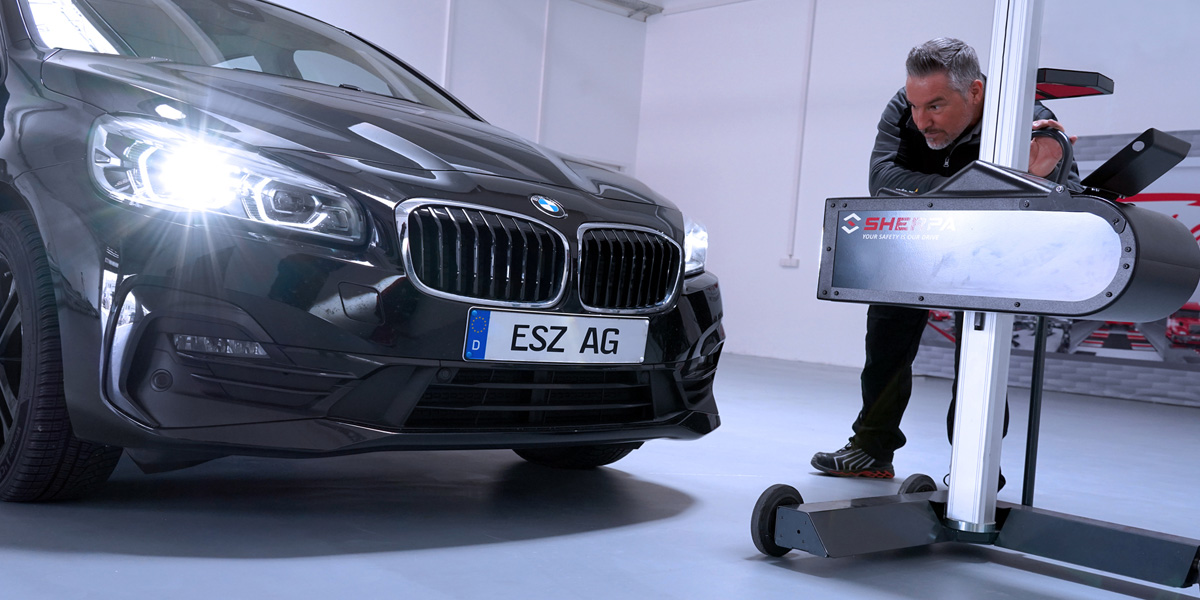Automotive testing technology
Calibration of
Automotive testing technology
The automotive industry uses a variety of testing equipment in all workshops, inspection centres, test centres and test bases of the technical inspection organisations (such as TÜV, Dekra & Co.) for the main inspection (HU). Brake test stands (BPS) determine the braking force of motor vehicles, headlight alignment test systems (SEPS) measure the angle of inclination of the headlights and exhaust gas measuring devices provide results on the emission values and particle quantities in the exhaust gas of the vehicles. esz AG calibrates this vehicle testing technology in cooperation with its partners, manufacturers and service organisations in the Calibration Expert Partner System (CEPS).



Accredited calibration
esz AG was the first provider in Germany to fulfil the extensive requirements profile of the German Accreditation Body (DAkkS) for validated measurement procedures in the field of automotive testing technology. Since 2017, the company and its partners within the Calibration Expert Partner Systems (CEPS) have been offering accredited calibrations for brake testers, headlight testers, exhaust gas measuring devices, pressure gauges and electrical pressure measuring devices in vehicle workshops and other test equipment.
Calibration of brake testers
Since 1 January 2017, brake testers must be calibrated by accredited providers. This applies to the initial commissioning of a brake tester and the regular calibration including a check for calibration capability (formerly “routine test”), which must be repeated at least every 24 months. Every intervention in the measured value recording also requires recalibration. The result of each calibration must be documented in a calibration certificate with the DAkkS accreditation symbol. Contractually bound companies in CEPS – Calibration Expert Partner System of esz AG can calibrate brake testers independently, on time and in accordance with the statutory regulations for vehicle testing technology.


Calibration of headlamp alignment test systems
Since the beginning of 2018, the legislator has also required the accredited calibration of headlamp alignment test systems (SEPS) on a fixed, marked measuring station to which the headlamp alignment tester is calibrated. Headlamp alignment systems, consisting of light alignment device and mounting surfaces, must be checked before initial commissioning and subsequently at least every 24 months. For their calibration, esz AG developed a practice-oriented calibration set consisting of a tripod, inclination angle adapter, levelling scale, tape measure, line laser and inclinometer. The traceability and calibration of this measuring equipment is also carried out by the specialists from Eichenau. The accredited procedure used to calibrate point and line lasers is unique in Germany. Contractually bound companies in the CEPS – Calibration Expert Partner System of esz AG can calibrate brake testers independently, on time and in accordance with the statutory regulations for vehicle testing technology.
Calibration of exhaust emission test devices
Since 1 January 2019, calibration has been mandatory for exhaust emission test devices (AU), which must also be traced by an accredited laboratory. All AU devices used must be calibrated in accordance with DAkkS.
The DAkkS calibration of flue gas measuring devices must be repeated at least every 12 months. In addition, every intervention in the measured value recording (e.g. during adjustment as part of annual maintenance) requires recalibration.


Calibration of exhaust particle number devices
Since 01.01.2023, the accredited calibration of exhaust particle measuring devices in workshops on site has been mandatory. The “AU device calibration guideline” sets out specific requirements for the calibration process and conformity assessment. Calibration of exhaust gas measuring devices by a service provider accredited in accordance with DIN EN ISO/IEC 17025 is required. Just like other AU devices, they must be calibrated before initial commissioning and then every 12 months. Opacimeters are still used for older diesel vehicles.
SYSKAP
With SYSKAP, the system solution for accredited calibration of exhaust particle measuring devices in the CEPS from esz AG, vehicle workshops and test centres meet the legal requirements quickly, safely and effectively. As a calibration laboratory, esz AG cooperates with the companies Knestel GmbH and Scale MT GmbH and offers an all-in-one solution consisting of hardware and software.
Calibration of pressure gauges and manometers
Benefit from esz AG’s many years of expertise and accreditation for the calibration of pressure gauges and manometers.
Motor vehicle companies that wish to offer official vehicle inspections and tests require accreditation in accordance with DIN EN ISO/IEC 17020. In Germany, this concerns the exhaust emissions test (AU/AUK) as well as the safety test (SP) and gas system test (GAP). The motor vehicle industry has established a central quality management system (QMS) for its companies with the AÜK system (Accredited Inspection in the Motor Vehicle Industry). In order to obtain AÜK approval from the DAkkS, all testing and measuring equipment used (e.g. measuring devices for the functional testing of air brake systems) must be calibrated by an accredited calibration laboratory in accordance with the standards. With CEPS, esz AG offers you an efficient and secure solution.


CEPS – makes it possible
esz AG offers the right platform for rule-compliant calibrations of vehicle testing technology through the digital networking of partners, manufacturers and service organisations: CEPS – Calibration Expert Partner System
Are you also interested in qualifying your technicians to meet the new challenges and becoming part of the esz AG network? Then take a look at the training courses for further education.
Your benefits
- Calibration of automotive testing technology directly in the company:
- Creation of individual calibration description with complete measurement uncertainty balance in accordance with EA 4/02 (prev. DAkkS-DKD-3)
- Integration of the existing service structure into the QM system in accordance with DIN EN ISO/IEC 17025:
- Training and education
- Monitoring and supervision
- Audit and monitoring
- Traceability of the calibration equipment / standards used, verification and test equipment monitoring
- Creation and provision of necessary templates, software, test equipment database and digital calibration certificates with cloud hosting
- Application, official processing, maintenance and assumption of all costs for accreditation with the DAkkS
- Contact person and constant support
More information
The new version of the brake tester directive (Verkehrsblatt 14-2021 No. 149) has been in force since 31.07.2022. In addition to type approval, it also regulates the periodic testing (calibration) of brake testers.
The main contents are:
- All brake testers used as part of the main inspection must be calibrated in accordance with DAkkS.
- The routine test is replaced by the periodic inspection and the results are presented in a calibration certificate.
- Documentation of the software versions of the BPS and the ASA interface.
There are many different requirements for SEPS.
- The SEP always requires a valid type approval with the approval number on the type plate. Only then can the SEPS be used for the main inspection.
- The exact measuring procedure for the calibration of SEPS depends on the commissioning date and the calibrations or routine tests carried out to date.
- In order for an SEPS to be used for the main inspection, it must have a calibration certificate as well as a passed routine test. In addition to visual inspections of the SEP and surfaces, the two installation surfaces for the SEP and the vehicle are checked for compliance with the specified tolerances for flatness and inclination as part of the routine inspection.
There are many different requirements for AU devices.
- In order to carry out the exhaust emission test as part of the HU, the AU devices used must be DAkkS-compliant calibrated (in accordance with Traffic Bulletin 11-2021 No. 133).
- From 01.07.2023, only particulate measuring devices will be permitted for emissions tests on diesel vehicles of the Euro 6 emissions standard or newer.
Calibration interval
- The regular accredited calibration must be repeated at least every 12 months to the nearest month in accordance with the AU device calibration guideline (Verkehrsblatt 11-2021 No. 133).
- In addition, recalibration must be carried out after every intervention in the measured value recording (e.g. during adjustment as part of annual maintenance). In addition, every intervention in the measured value recording (e.g. during adjustment as part of annual maintenance) requires recalibration.
Transport Gazette 14/2021 No. 149 (“BPS Guideline 2021”)
- The error limit for the display of brake pressures for air brake systems is ±1 % of the full scale value.
- The resolution of the displays must be at least 0.1 bar for pneumatic brake systems.
- Test interval (= calibration interval): 24 months
- The accredited calibration of pressure measuring devices is carried out in accordance with guideline DKD-R 6-1.
- Procedure C is selected as the calibration procedure in accordance with DKD-R 6-1 for all pressure gauges for the functional testing of air brake systems.
- Sequence C contains an upward series and a downward series, each with at least 5 pressure stages including zero point, evenly distributed over the entire measuring range.
- The expanded measurement uncertainty includes the zero point deviation (zero point before the upward series and after the downward series) and the reversal span (difference between the deviations of the respective measured values in the upward and downward series).
- Ambient temperature during calibration is ideally in the range +18 °C to +28 °C, max. in the range +10 °C to +35 °C, temperature fluctuation during calibration is maximum 5 K.
- An accredited calibration certificate is issued for each pressure sensor/manometer in the CEPS of esz AG.

